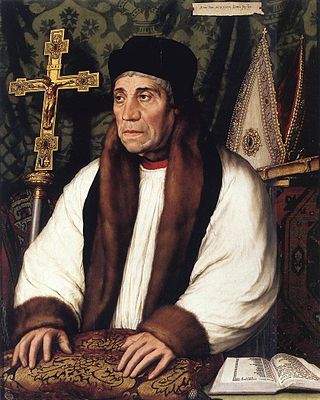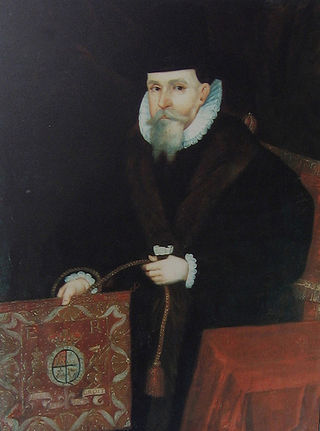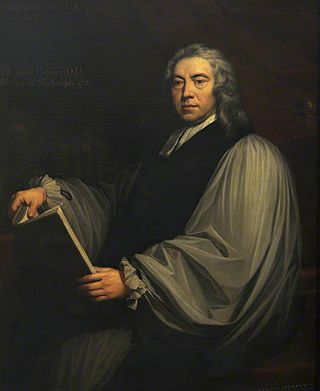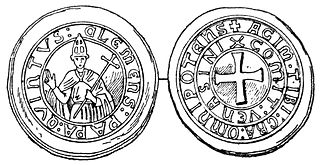
William Warham was the Archbishop of Canterbury from 1503 to his death.

Charles Manners-Sutton was a bishop in the Church of England who served as Archbishop of Canterbury from 1805 to 1828.
John de Gray or de Grey was an English prelate who served as Bishop of Norwich, and was elected but unconfirmed Archbishop of Canterbury. He was employed in the service of Prince John even before John became king, for which he was rewarded with a number of ecclesiastical offices, culminating in his pro forma election to Norwich in 1200. De Gray continued in royal service after his elevation to the episcopate, lending the King money and undertaking diplomatic missions on his behalf. In 1205 King John attempted to further reward de Gray with a translation to the archbishopric of Canterbury, but a disputed election process led to de Gray's selection being quashed by Pope Innocent III in 1206.

Adam Loftus was Archbishop of Armagh, and later Dublin, and Lord Chancellor of Ireland from 1581. He was also the first Provost of Trinity College Dublin.

Thomas Arundel was an English clergyman who served as Lord Chancellor and Archbishop of York during the reign of Richard II, as well as Archbishop of Canterbury in 1397 and from 1399 until his death, an outspoken opponent of the Lollards. He was instrumental in the usurpation of Richard by his cousin Henry Bolingbroke, who became Henry IV.

William Connor Magee was an Irish clergyman of the Anglican church, Bishop of Peterborough 1868–1891 and Archbishop of York for a short period in 1891.

Thomas Tanner was an English antiquary and prelate. He was Bishop of St Asaph from 1732 to 1735.
The Lord High Chancellor of Ireland was the highest judicial office in Ireland until the establishment of the Irish Free State in 1922. From 1721 to 1801, it was also the highest political office of the Irish Parliament: the Chancellor was Speaker of the Irish House of Lords. The Lord Chancellor was also Lord Keeper of the Great Seal of Ireland. In all three respects, the office mirrored the Lord High Chancellor of Great Britain.

Walter Langton of Castle Ashby in Northamptonshire, was Bishop of Coventry and Lichfield and Treasurer of England. The life of Langton was strongly influenced by his uncle William Langton, Archbishop of York-elect, by Robert Burnell, Lord Chancellor of England and then by the years in which he served King Edward I. Lichfield Cathedral was improved and enriched at his expense.

The Dean of St Patrick's Cathedral is the senior cleric of the Protestant St Patrick's Cathedral, Dublin, elected by the chapter of the cathedral. The office was created in 1219 or 1220, by one of several charters granted to the cathedral by Archbishop Henry de Loundres between 1218 and 1220.
John de Sandford was Archbishop of Dublin.
Richard Courtenay was an English prelate and university chancellor, who served as Bishop of Norwich from 1413 to 1415.
William Ayermin was a medieval Bishop of Norwich.
William de la Corner was a medieval Bishop of Salisbury, who fought a long but unsuccessful battle to become Archbishop of Dublin.
Fromund le Brun was a cleric and judge in thirteenth-century Ireland who became Lord Chancellor of Ireland. He lost a long battle to become Archbishop of Dublin, due largely to his notorious pluralism. He also clashed bitterly with the formidable Archbishop of Cashel, David Mac Cerbaill, who excommunicated him.
John de St Paul, also known as John de St. Pol, John de Owston and John de Ouston, was an English-born cleric and judge of the fourteenth century. He was Archbishop of Dublin 1349–62 and Lord Chancellor of Ireland 1350–56. He had previously been Master of the Rolls in England 1337–40. Apart from a brief period of disgrace in 1340, he enjoyed the confidence of King Edward III. He was described as a zealous supporter of English rule in Ireland, but also as a pragmatic statesman who was willing to conciliate the Anglo-Irish ruling class. He did much to enlarge and beautify Christ Church, Dublin, although virtually no trace of his improvements survive, as they were destroyed by the Victorian rebuilding of the cathedral.

The medieval University of Dublin was an early but generally unsuccessful attempt to establish a university in Dublin, the capital city of the Lordship of Ireland. Founded in 1320, it maintained an intermittent existence for the next two centuries, but it never flourished, and disappeared for good at the Reformation in Ireland (1534–41). It was located in Saint Patrick's Cathedral, Dublin. It had no connection with the present University of Dublin, better known as Trinity College Dublin, which was founded in 1592.
John de Derlington was an English Dominican, Archbishop of Dublin and theologian.
Thomas de Chaddesworth, de Chedworth or de Chadsworth (c.1230-1311) was an English-born Crown servant and cleric who spent some fifty years in Ireland, and died there at a great age.
Ralph de Norwich (c.1180–1259) was an English-born cleric, judge and Crown servant to King John and King Henry III, much of whose career was spent in Ireland, where he held office as Lord Chancellor of Ireland for several years. He was elected Archbishop of Dublin in 1256, but his election was vetoed by the Pope, on the grounds that he was essentially a secular official, and too devoted to the King's interests to be a good servant of the Pope.








